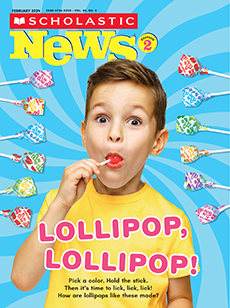Busy, Busy Bat! Lesson Plan
Academic Standards
Reading Objective:
Children will discuss how bats help fruits grow.
Science Focus:
organisms and environments
ELA Skills:
key details, vocabulary, writing, text evidence, writing, text features
Page 4 Skill:
read a chart
Vocabulary:
nocturnal, nectar, pollen
CCSS:
SL.2.3, RI.2.1, RI.2.4, RI.2.8, RI.2.10, L.2.1, RI.2.5
Guided Reading Level:
J
Lexile Level:
480L
Provide students with some background on bats.
Build background knowledge (10 min.)
Watch our video "Night Flyer." After children have finished watching the video, discuss the following question:
- Bats are nocturnal. What does that mean?
Preview vocabulary (3 min.)
Next, play the online vocabulary slideshow. This issue’s featured words are noctural, nectar and pollen.
Set a purpose for reading (5 min.)
- Pass out the issue, and discuss the cover. How do children think the bat might be helping plants?
- Next, read the As You Read prompt on page 2: “Think about how bats help fruits grow.” Encourage children to think about this prompt as they read.
Read together (20 min.)
Pass out the Read and Think printable. Use it to check comprehension as you read the issue together, pausing to ask the questions.
Assessment: Reading Quiz
Pass out the Reading Quiz to review key concepts from the issue and assess students’ proficiency on key nonfiction reading skills.
- In our “Help the Bats Fly” game, children practice when to capitalize words. Each time they choose a correct word to complete a sentence, a bat flies off the branch!
You can use our printable worksheets to focus on important ELA skills. Here’s how.
ELA Focus: Vocabulary (15 min.)
- Use the Word Work printable to deepen students’ understanding of the words noctunal, nectar, and pollen.
Editor’s Pick: Text Evidence (15 min.)
- Norbert Know-It-All is a beloved character—but he doesn’t know as much as he thinks he does! Print out his letter and put it in an envelope addressed to your class. Then read the letter aloud. Norbert says he’s an “expert” on bats, but students will disagree! They can write their own letter proving him wrong and send it to [email protected]. Norbert will write back!
ELA Focus: Text Features (15 min.)
- The Text-Feature Hunt printable is a great way to help students recognize and use nonfiction text features, including headlines, subheadings, captions, and bold words. Children can hunt for each text feature in the magazine, circle it, and then fill in the answers on the sheet.
Here are two past issues you can use to extend your lesson on nocturnal animals:
- “Look Out, Mouse!,” October 2020. In narrative form, this issue teaches the adaptations of two nocturnal animals: owls and mice.
- “Ghost in the Night,” October 2017. This issue introduces students to the ghost bat.
You can find a higher-Lexile-level and a lower-Lexile-level version of the article online here:
- Higher-Lexile level: 490L
- Lower-Lexile level: 450L
